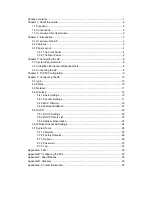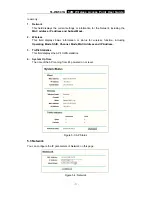
TL-WA501G
54M Wireless Access Point User Guide
Chapter 3: Connecting the AP
3.1 System Requirements
¾
Broadband Internet Access Service (DSL/Cable/Ethernet)
¾
One DSL/Cable Modem that has an RJ45 connector
¾
A Ethernet broadband router
¾
TCP/IP protocol must be installed on each PC
¾
Web browser, such as Microsoft Internet Explorer 5.0 or later, Netscape Navigator
6.0 or later
¾
802.11g or 802.11b-compliant devices, such as the TL-WN510G Wireless Adapter
3.2 Installation Environment Requirements
¾
Not
in direct sunlight or near a heater or heating vent
¾
Not cluttered or crowded. There should be at least 2 inches (5 cm) of clear space on
all sides of the AP
¾
Well ventilated (especially if it is in a closet)
¾
Operating temperature: 0
℃
~40
℃
(32
℉
~104
℉
)
¾
Operating Humidity: 10%~90%RH, Non-condensing
3.3 Connecting the AP
Figure 3.1 is an example of an infrastructure network incorporating the TL-WA501G. An
Infrastructure network contains an access point or a wireless router. For a typical
connection of the AP, please do the following:
1. You will need broadband Internet access (a Cable or DSL-subscriber line into your
home or office). Consult with your Cable or DSL provider for proper installation of the
modem.
2. Connect the Cable or DSL modem to a Router. Quickly install the router.
3. Locate an optimum location for the AP. The best place is usually near the center of
the area in which your PC(s) will wirelessly connect. The place must accord with the
Installation Environment Requirements
.
4. Adjust the direction of the antenna. Normally, upright is a good direction.
5.
Connect the Ethernet Broadband Router to the TL-WA501G AP. Power on the AP.
6. If you are connecting a desktop PC or laptop to your network, install the TP-LINK
Wireless Adapter on the PC.
-
6
-


























